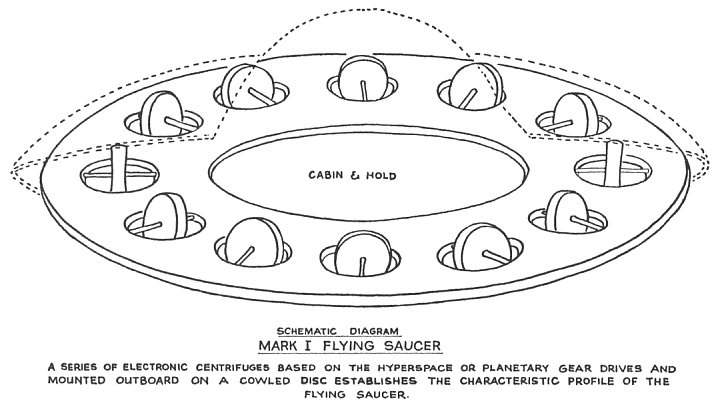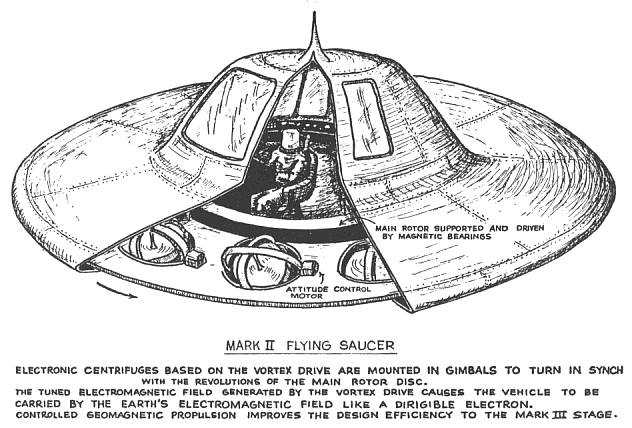For all practical purposes, you do not have to understand what Newton and Einstein mean by gravity. Gravity is an acceleration downward, to the center of the earth. Therefore, antigravity is an acceleration upward. As far as practical engineering is concerned, any means to achieve a gain in altitude is an antigravity engine. An airplane is an antigravity engine, a balloon is an antigravity engine, a rocket is an antigravity engine, a stepladder is an antigravity engine. See how easy it is to invent an antigravity engine?
There are three basic kinds of locomotive engines. The primary principle is traction. The foot and the wheel are traction engines. The traction engine depends upon friction against a surrounding medium to generate movement, and locomotion can proceed only as far and as speedily as the surrounding friction will provide. The secondary principle is displacement. The balloon and the submarine rise by displacing a denser medium; they descend by displacing less than their weight. The tertiary drive is the rocket engine.
A rocket is driven by reaction from the mass of material it ejects. Although a rocket is most efficient when not impeded by a surrounding medium, it must carry not only its fuel but also the mass it must eject. As a consequence, the rocket is impractical where powerful acceleration is required for extended drives. In chemical rocketry, ten minutes is a long burn for powered flight. What is needed for practical antigravity locomotion is a fourth principle which does not depend upon a surrounding medium or ejection of mass.
You must take notice that none of the principles of locomotion required any new discovery. They have all been around for thousands of years, and engineering only implemented the principle with increasing efficiency. A fourth principle of locomotion has also been around for thousands of years. It is centrifugal force. Centrifugal force is the principle of the military sling and medieval catapult.
Everyone knows that centrifugal force can overcome gravity. If directed upward, centrifugal force can be used to drive an antigravity engine. The problem engineers have been unable to solve is that centrifugal force is generated in all directions on the plane of the centrifuge. It won't provide locomotion unless the force can be concentrated in one direction. The solution of the sling, of releasing the wheeling at the instant the centrifugal force is directed along the ballistic trajectory, has all the inefficiencies of a cannon. The difficulty of the problem is not real, however. There is a mental block preventing people from perceiving a centrifuge to be anything other than a flywheel.
A bicycle wheel is a flywheel. If you remove the rim and tire, leaving only the spokes sticking out from the hub, you still have a flywheel. In fact, spokes alone make a more efficient flywheel than the complete wheel; this is because momentum goes up only in proportion to mass but with the square of speed. Spokes are made of drawn steel with extreme tensile strength, so spokes alone can generate the highest levels of centrifugal force long after the rim and tire have disintegrated. But spokes alone still generate centrifugal force equally in all directions from the plane of rotation. All you have to do to concentrate centrifugal force in one direction is remove all the spokes but one. That one spoke still functions as a flywheel, even though it is not a wheel any longer.
See how easy it is once you accept an attitude of solving one problem at a time as you come to it? You can even add a weight to the end of the spoke to increase the centrifugal force.
But our centrifuge still generates a centrifugal acceleration in all directions around the plane of rotation even though it doesn't generate acceleration equally in all directions at the same time. All we have managed to do is make the whole ball of wire wobble around the common center of mass between the axle and the free end of the spoke. To solve this problem, now that we have come to it, we need merely to accelerate the spoke through a few degrees of arc and then let it complete the cycle of revolution without power.
As long as it is accelerated during the same arc at each cycle, the locomotive will lurch in one direction, albeit intermittently. But don't forget that the piston engine also drives intermittently. The regular centrifugal pulses can be evened out by mounting multiple centrifuges on the same axle so that a pulse from another flywheel takes over as soon as one pulse of power is past its arc.
The next problem facing us is that the momentum imparted to the centrifugal spoke carries it all around the cycle with little loss of velocity. The amount of concentrated centrifugal force carrying the engine in the desired direction is too low to be practical. Momentum is half the product of mass multiplied by velocity squared. Therefore, what we need is a spoke that has a tremendous velocity with minimal mass. They don't make spokes like that for bicycle wheels. A search through the engineers' catalog, however, turns up just the kind of centrifuge we need.
An electron has no mass at rest (you cannot find a smaller minimum mass than that); all its mass is inherent in its velocity. So we build an electron raceway in the shape of a doughnut in which we can accelerate an electron to a speed close to that of light. As the speed of light is approached, the energy of acceleration is converted to a momentum approaching infinity. As it happens, an electron accelerator answering our need was developed by the University of California during the last years of World War II. It is called a betatron, and the doughnut is small enough to be carried comfortably in a man's hands.
We can visualize the operation of the Mark I from what is known about particle accelerators. To begin with, high-energy electrons ionize the air surrounding them. This causes the betatrons to glow like an annular neon tube.

Therefore, around the rim of the saucer a ring of lights will glow like a string of shining beads at night. The power required for flight will ionize enough of the surrounding atmosphere to short out all electrical wiring in the vicinity unless it is specially shielded. In theory, the top speed of the Mark I is close to the speed of light; in practice, there are many more problems to be solved before relativistic speeds can be approached.
The peculiar property of microwaves heating all material containing the water molecule means that any animal luckless enough to be nearby may be cooked from the inside out; vegetation will be scorched where a saucer lands; and rocks containing water of crystallization will be blasted. Every housewife with a microwave oven knows all this; only hard-headed scientists and softheaded true believers are completely dumbfounded.
The UFOnauts would be cooked by their own engines, too, if they left the flight deck without shielding. This probably explains why a pair of UFOnauts, in a widely published photograph, wear reflective plastic jumpsuits. Mounting the betatrons outboard on a disc is an efficient way to get them away from the crew's compartment, and the plating of the hull shields the interior. At high accelerations, increasing amounts of power are transformed into radiation, making the centrifugal drive inefficient in strong gravitational fields.
The most practical employment of this engineering is for large spacecraft, never intended to land. The flying saucers we see are very likely scouting craft sent from mother ships moored in orbit. For brief periods of operation, the heavy fuel consumption of the Mark I can be tolerated, along with radiation leakage - especially when the planet being scouted is not your own...




Replies
Can you really fly it?llol